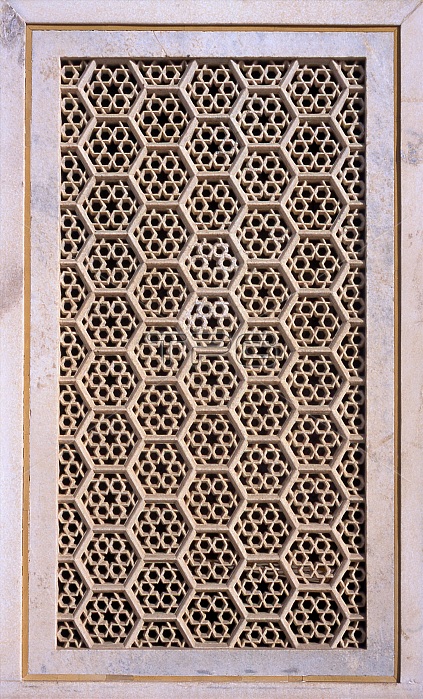
A jali (or jaali, Gujarati ????) is the term for a perforated stone or latticed screen, usually with an ornamental pattern constructed through the use of calligraphy and geometry. Early work was performed by carving into stone, while the later used by the Mughals employed the technique of inlay, using marble and semi-precious stones. Jali typically use Floral geometric patterns. Etimad-ud-Daula's Tomb (Urdu: ?????? ?????? ?? ??????, I'tim?d-ud-Daulah k? Maqbara) is a Mughal mausoleum in the city of Agra in the Indian state of Uttar Pradesh. Along with the main building, the structure consists of numerous outbuildings and gardens. The tomb, built between 1622 and 1628 represents a transition between the first phase of monumental Mughal architecture - primarily built from red sandstone with marble decorations, as in Humayun's Tomb in Delhi and Akbar's tomb in Sikandra - to its second phase, based on white marble and pietra dura inlay, most elegantly realized in the T?j Mahal. The mausoleum was commissioned by N?r Jah?n, the wife of Mughal emperor Jahangir, for her father Mirz? Ghiy?s Beg, originally a Persian Amir in exile, who had been given the title of I'tim?d-ud-Daulah (Pillar of the State). Mirz? Ghiy?s Beg was also the grandfather of Mumt?z Mah?l (originally named Arj?mand B?no, daughter of Asaf Kh?n), the wife of the emperor Sh?h Jah?n, responsible for the construction of the T?j Mahal.
| px | px | dpi | = | cm | x | cm | = | MB |
Details
Creative#:
TOP27331563
Source:
達志影像
Authorization Type:
RM
Release Information:
須由TPG 完整授權
Model Release:
No
Property Release:
No
Right to Privacy:
No
Same folder images:

 Loading
Loading